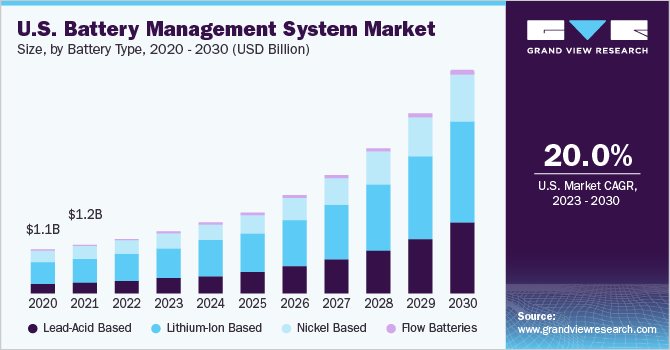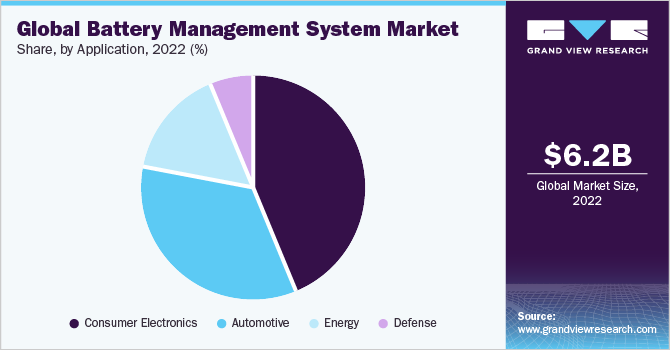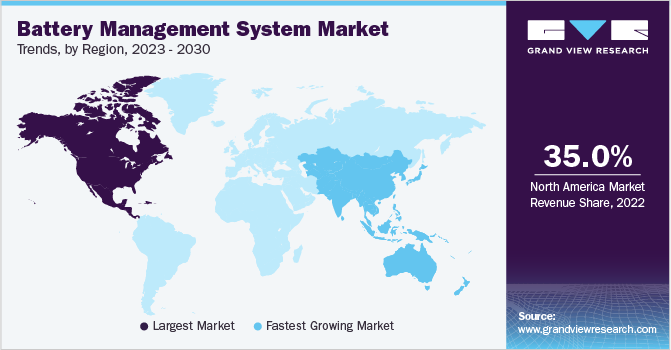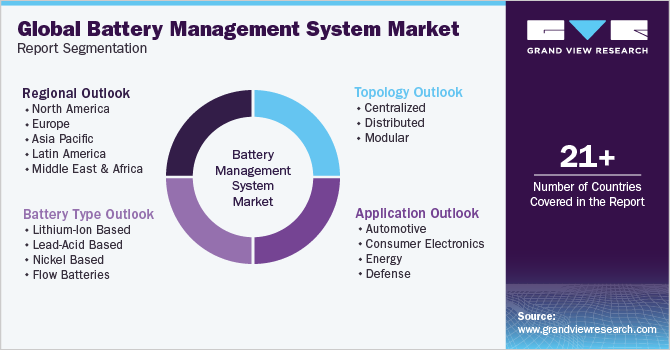- Home
- »
- Power Generation & Storage
- »
-
Battery Management System Market Size & Share ReportGVR Report cover
![Battery Management System Market Size, Share, & Trends Report]()
Battery Management System Market Size, Share, & Trends Analysis Report By Battery Type (Lithium-Ion Based, Lead-Acid Based), By Topology, By Application, By Region, And Segment Forecasts, 2023 - 2030
- Report ID: GVR-1-68038-747-6
- Number of Report Pages: 114
- Format: PDF, Horizon Databook
- Historical Range: 2017 - 2021
- Forecast Period: 2023 - 2030
- Industry: Energy & Power
Report Overview
The global battery management system market size was valued at USD 6.19 billion in 2022 and is expected to grow a CAGR of 23.4% from 2023 to 2030. Battery management systems are widely used in rechargeable batteries mounted in electric vehicles. The growth of the batter management systems market can be attributed to the increasing adoption of Electric Vehicles (EVs) and Hybrid Electric Vehicles (HEVs) across the globe owing to stringent policies, such as Kyoto protocol, implemented to curb Greenhouse Gas (GHG) emissions. In addition, the growing demand for renewable energy sources, such as solar and wind power, also fuels the demand for battery management systems to manage the batteries used in energy storage systems. Moreover, the rising need for efficient battery performance and extended battery life is also contributing to the growth of the battery management system.

A battery management system (BMS) offers several benefits for various applications, including electric vehicles, energy storage systems, and consumer electronics. Some of the key benefits of BMS include enhanced battery performance, improved safety, increased efficiency, remote monitoring and control, and enhanced user experience. For instance, BMS enables remote monitoring and control of battery performance, which is essential for applications such as energy storage systems and electric vehicles. This feature allows operators to monitor battery status, identify potential issues, and adjust remotely, improving overall efficiency and reducing maintenance costs.
Advancements in rechargeable battery technology, such as solid-state batteries, lithium-sulfur batteries, and flow batteries, are expected to drive the demand for battery management systems. These new battery technologies offer higher energy density, faster-charging rates, and longer life than traditional batteries, but they also have different charging and discharging characteristics, which require specialized BMSs for optimal performance and safety. Governments worldwide are implementing regulations to reduce greenhouse gas emissions. As a result, the demand for rechargeable batteries, which are equipped with BMS technology and are more environmentally friendly than disposable batteries, is expected to increase. Furthermore, the growing demand for consumer electronics devices such as smartphones, laptops, tablets, and wearable devices with rechargeable batteries is expected to fuel the growth of the battery management system industry.
Leading suppliers in the battery market are utilizing the most advanced technologies such as BMS to improve the durability and lifespan of batteries during usage. BMS prevents overcharging and over-discharging by regulating the charging and discharging process, thereby improving the durability of the battery system. In addition, BMS monitors the temperature of the battery system, preventing overheating, which can cause thermal runaway and lead to battery failure. Moreover, to prevent thermal runaway, temperature monitoring can also help identify potential issues with the battery system. For example, if a particular cell in the battery pack is consistently running at a higher temperature than other cells, it may indicate a problem with the cell or the BMS itself. Early detection of such issues can prevent further damage to the battery system and improve its durability.
Although BMS provides numerous benefits such as improved battery performance and safety, their use can increase the final cost of a product or application. This may discourage product manufacturers from using BMS, particularly in cost-sensitive markets, leading to reduced demand. Furthermore, in several emerging economies, the scarcity of skilled labor capable of implementing or testing BMSs may hinder the growth of the battery management system industry.
COVID-19 Insight
The global economy and the battery management system industry growth have been adversely impacted by the COVID-19 pandemic. The pandemic has caused significant economic downturns and disruptions in the supply chain across many countries. To prevent the spread of the virus, governments worldwide implemented complete lockdowns, resulting in industry shutdowns and subsequent disruptions in the supply chain. The lockdowns also caused a shortage of labor and materials worldwide, leading to delays in the manufacturing and distribution of batteries. Furthermore, the pandemic has adversely affected the sales of electric vehicles, leading to reduced demand for batteries.
Battery Type Insights
The lead-acid-based segment led the market and accounted for more than 49.0% share of the global revenue in 2022. Lead-acid batteries are a commonly used type of rechargeable battery with a substantial Topology, making them an attractive option for various applications. They are known for their reliability and low cost per wattage, making them highly popular among different industries. The cost-effectiveness of lead-acid batteries is unparalleled when a large Topology is required, making them an excellent choice for applications that need high energy storage at a lower cost. Due to their cost-effectiveness and high Topology, lead-acid batteries find widespread use in electric vehicles and automobiles.
The lithium-ion based segment is anticipated to grow at the highest CAGR during the forecast period, owing to rising usage of portable devices, such as tablets, mobile phones, and Bluetooth devices. In addition, these batteries provide multiple benefits, including lightweight, high adaptability for different applications, can withstand a significant number of charge/discharge cycles, are easy to maintain, and a longer life span. These benefits are driving the adoption of lithium-ion batteries several in applications. On the other hand, the nickel-based battery segment is also anticipated to witness significant growth in the coming years. These batteries are charged with less stress and at high speed and offer an extended shelf life. They perform well under rigorous working conditions and are low in cost. They are used in professional cameras, power tools, two-way radios, and emergency medical equipment.
Topology Insights
The centralized segment dominated the market and accounted for more than 43.0% share of the global revenue in 2022. The centralized BMS functions as a single pack controller that monitors, balances, and manages all cells in the battery pack. Designing and building a centralized BMS is simpler and more cost-effective compared to other topologies. Centralized BMS are majorly used in medium-power applications such as e-bikes, portable medical equipment, portable devices, home appliances, and many other applications.
The distributed segment is expected to grow at the highest CAGR over the forecast period. In a distributed BMS topology, the battery cells in the system are managed by multiple control units. One of the significant benefits of utilizing a distributed BMS is its resilience, as it can continue to function effectively even in the event of one or more control unit failures. In addition, compared to other BMS topologies, a distributed BMS is growing in popularity due to its distinctive design. A distributed BMS features electronics that are housed on cell boards, which are placed directly on the cells being measured. Instead of numerous tap wires running between the cells and electronics, a distributed BMS only requires a few communication wires between the cell boards and a BMS controller that performs computation and communication functions. Thus, the abovementioned benefits of the distributed BMS are propelling the segment’s growth.
Application Insights
The consumer electronics segment accounted for over 43.0% share of the market in 2022. The increasing adoption of battery management systems in consumer electronics applications is boosting the segment’s growth. They are widely used in portable electronics, with a high-energy density, low self-discharge, and tiny memory effect. In consumer electronics, BMSs are typically used to ensure the safe and efficient use of lithium-ion batteries, which are commonly used in these devices due to their high energy density and long cycle life.

The automotive segment is expected to grow at the highest CAGR over the forecast period. According to the "Global EV Outlook 2021" report published by the International Energy Agency (IEA), electric two-wheelers make up a significant proportion of the world's electric vehicles (EV), with a current estimated stock of around 290 million, and this number continues to grow. The popularity of two-wheelers among electric vehicles is leading to rising demand for EV batteries in this segment.Strategic initiatives undertaken by the key market players to launch BMS for EVs are further fueling the segment’s growth. For instance, in May 2022, Marelli Holdings Co., Ltd., a leading automotive supplier unveiled plans to enhance its existing lineup of battery management technologies for EVs by introducing an advanced Wireless Distributed Battery Management System (wBMS).
Regional Insights
The North America region dominated the market and accounted for more than a 35.0% share of the global revenue in 2022. The growth of the market can be attributed to the advances in battery technology, which have led to the development of more efficient and long-lasting batteries. The increasing support from both the federal government and various state governments is also encouraging the adoption of EVs, thereby driving the demand for battery management systems.

The Asia Pacific region is expected to grow at the highest CAGR during the forecast period. The battery management system market in the region has experienced significant growth in recent years, driven by the increasing demand for EVs and renewable energy systems in the region. Countries such as China, Japan, and South Korea have emerged as major markets for BMS technology, with several domestic and international companies investing in the development of advanced BMS solutions. For instance, in November 2022, Renon India Private Limited, an energy storage company, launched its Alpha smart swappable battery platform for high-performance electric two-wheelers. The platform, which hosted several patented technologies, including cell interconnects and sensing circuits, utilized Renon India Private Limited’s proprietary battery management system and telematics hardware.
Key Companies & Market Share Insights
The market players are continuously working towards new product development and up-gradation of their existing product portfolio. For strategic growth, these players prefer collaborations with other players or EV manufacturers. In January 2023, Hero Electric, India's leading electric scooter company announced a long-term partnership with a battery management system provider, Maxwell Energy Systems for the supply of advanced battery management systems for its two-wheeled electric vehicles. Under this partnership, Maxwell Energy Systems is expected to supply over a million BMS units to Hero Electric. In addition, in February 2021, German automotive parts supplier, Hella has announced its plans to broaden its range of high-voltage battery management systems for electric vehicles by introducing a 48-volt battery management system in series production by the summer of 2024. Some prominent players in the global battery management system market include:
-
Elithion, Inc.
-
Johnson Matthey PLC
-
Analog Devices
-
Lithium Balance A/S
-
NXP Semiconductor N.V.
-
Nuvation Engineering
-
Texas Instruments, Inc.
-
Leclanché SA
-
Eberspaecher Vecture Inc.
-
Infineon Technologies AG
Battery Management System Market Report Scope
Report Attribute
Details
Market size value in 2023
USD 7.19 billion
Revenue forecast in 2030
USD 31.27 billion
Growth rate
CAGR of 23.4% from 2023 to 2030
Base year of estimation
2022
Historical data
2017 - 2021
Forecast period
2023 - 2030
Quantitative units
Revenue in USD million, and CAGR from 2023 to 2030
Report coverage
Revenue forecast, company market share, competitive landscape, growth factors, and trends
Segments covered
Battery type, topology, application, region
Regional scope
North America; Europe; Asia Pacific; Latin America; MEA
Country scope
U.S.; Canada; Mexico; UK; France; Germany; Netherlands; Norway; China; India; Australia; South Korea; Japan; Brazil; Kingdom of Saudi Arabia; UAE; South Africa
Key companies profiled
Elithion, Inc.; Johnson Matthey PLC; Analog Devices; Lithium Balance A/S; NXP Semiconductor N.V.; Nuvation Engineering; Texas Instruments Inc.; Leclanché SA; Eberspaecher Vecture Inc.; Infineon Technologies AG
Customization scope
Free report customization (equivalent up to 8 analysts working days) with purchase. Addition or alteration to country, regional & segment scope
Pricing and purchase options
Avail customized purchase options to meet your exact research needs. Explore purchase options
Global Battery Management System Market Report Segmentation
This report forecasts revenue growth at global, regional, and country levels and provides an analysis of the latest industry trends in each of the sub-segments from 2017 to 2030. For this study, Grand View Research has segmented the global battery management system market report based on battery type, topology, application, and region:

-
Battery Type Outlook (Revenue, USD Million, 2017 - 2030)
-
Lithium-Ion Based
-
Lead-Acid Based
-
Nickel Based
-
Flow Batteries
-
-
Topology Outlook (Revenue, USD Million, 2017 - 2030)
-
Centralized
-
Distributed
-
Modular
-
-
Application Outlook (Revenue, USD Million, 2017 - 2030)
-
Automotive
-
Consumer Electronics
-
Energy
-
Defense
-
-
Regional Outlook (Revenue, USD Million, 2017 - 2030)
-
North America
-
U.S.
-
Canada
-
Mexico
-
-
Europe
-
UK
-
Germany
-
France
-
Netherlands
-
Norway
-
-
Asia Pacific
-
China
-
India
-
Japan
-
Australia
-
South Korea
-
-
Latin America
-
Brazil
-
-
MEA
-
Kingdom of Saudi Arabia
-
UAE
-
South Africa
-
-
Frequently Asked Questions About This Report
b. The global battery management system market size was estimated at USD 6.19 billion in 2022 and is expected to reach USD 7.19 billion in 2023.
b. The global battery management system market is expected to grow at a compound annual growth rate of 23.4% from 2023 to 2030 to reach USD 31.27 billion by 2030.
b. North America dominated the battery management system market with a share of over 35.0% in 2022. This is attributable to increasing penetration of EVs coupled with supportive government initiatives.
b. Some key players operating in the battery management system market include Elithion, Inc.; Johnson Matthey PLC; Analog Devices; Lithium Balance A/S; NXP Semiconductor N.V.; Nuvation Engineering; Texas Instruments Inc.; Leclanché SA; Eberspaecher Vecture Inc.; Infineon Technologies AG.
b. Key factors that are driving the battery management system market growth include the increasing adoption of Electric Vehicles (EVs) and Hybrid Electric Vehicles (HEVs) across the globe owing to stringent policies, such as Kyoto protocol, implemented to curb Greenhouse Gas (GHG) emissions.
Share this report with your colleague or friend.
![gvr icn]()
NEED A CUSTOM REPORT?
We can customize every report - free of charge - including purchasing stand-alone sections or country-level reports, as well as offer affordable discounts for start-ups & universities. Contact us now
![Certified Icon]()
We are GDPR and CCPA compliant! Your transaction & personal information is safe and secure. For more details, please read our privacy policy.
We are committed towards customer satisfaction, and quality service.
"The quality of research they have done for us has been excellent."





